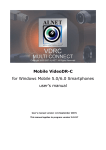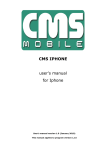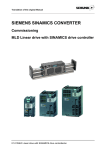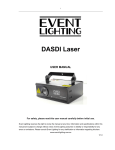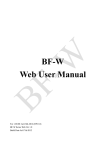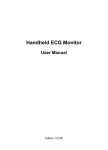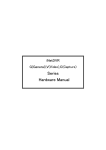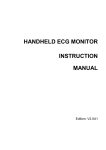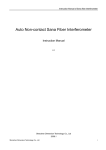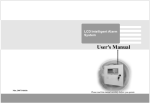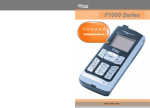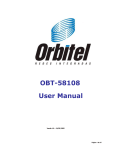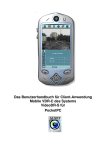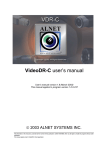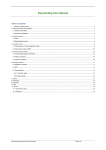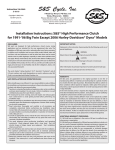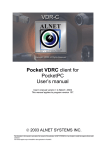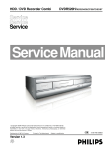Download manual EN
Transcript
CMS Mobile for Blackberry phones user's manual User's manual version 1.0 (December 2009) This manual applies to program version 2.0.7 Table of contents 1. Introduction......................................................................................................................3 1.1 System Description 4 2. Running the application and interface description......................................................5 3. Using the application.......................................................................................................6 3.1 Basic options 3.2 Establishing the connection 3.3 Additional options during the connection 3.4 Managing the address book 3.4.1 Adding the new entry to the address book 3.4.2 Editing the entry in the address book 3.4.3 Deleting the entry from the address book 3.4.4 Changing the entry position in the address book list 3.5 Selecting the camera 3.6.1 Layout (multiview) 3.6 Picture quality and data transfer settings 3.6.1 Enhance the camera quality for static images 3.7 Controlling the output switches 3.8 Displaying the available alarm inputs 3.9 Archive 3.10 PTZ control mode 3.10.1 PTZ Preset Function 3.11 Zoom 3.13 „About” window 3.14 Closing the program 3.15 Help 6 7 8 9 10 11 12 12 13 13 14 15 16 16 18 19 19 20 22 22 22 4. Keyboard shortcuts.......................................................................................................23 5. Contact info....................................................................................................................24 Page 2 1. Introduction 1. INTRODUCTION We present to you next version of CMS mobile system with many new functions and modules. Many of these changes is the effect of our cooperation with You and our Partners. Part of them are our ideas which extend capabilities of digital video recording. Please pay your attention to the possibilities of simultaneous image recording from network cameras and, widely used so far, analog cameras, developed archives and wider capabilities of controlling the whole system. MENU RETURN ZOOM IN PRESET ZOOM OUT ARCHIVE MULTIVIEW Page 3 1. Introduction 1.1 SYSTEM DESCRIPTION Net Hybrid is a digital video recorder designed for cooperation with CCTV cameras. It uses PC class computers which work under control of Microsoft Windows VISTA/7 operating system. New Net Hybrid system version can record image from up to 32 cameras, servicing 32 output switches and 32 alarm inputs. Moreover the system can be hybrid, that is one system can service both analog an IP cameras – thanks to this it is possible to upgrade an existing installation and add IP or analog cameras. Managing the video server through the network is possible. Program allows wide possibilities of motion detection settings, searching the motion in archives, servicing alarm events. Differential image-compression method guarantees image recording longer than in other systems of that type without changing the image quality and storage space. Software for managing CMS MOBILE system consists of two independent applications: 1. NET Hybrid (Video Digital Recording - Server) 2. CMS PROFFESIONAL (Client) The first application is a server: processes image from the cameras, manages user accounts, tasks, controls the cameras. The second one is used as a client. We can connect to the server by a any network and do remote monitoring. Client application is available on mobile devices which allows access to camera images from any place in the world. Page 4 2. Running the application and interface description 2. RUNNING THE APPLICATION AND INTERFACE DESCRIPTION The program is designed to work with the Blackberry Operating System, and works with phones equipped with that system. This user's manual is based on program version 2.0.7 CMS MOBILE installed on Blackberry Bold (9000) with 5.0.0.411 OS. This program can be downloaded free of charge from the www.alnetsystems.com website. After copying it to the blackberry and setting the permissions, the program is ready to run. In order to run it, just click the CMS icon in the main menu. The main camera window looks like that. Camera number Camera name and model Digit 4 and red figure means that there is a movement in camera 4 Main screen displays the cameras picture. After pressing T button the number of frames and actual hour is being displayed Picture 1: Program's main window Page 5 3. Using the application 3. USING THE APPLICATION 3.1 BASIC OPTIONS Picture2: Basic program options After program start, in the main window, the following options are available after pressing MENU button: ● Connect – opens the address book with the list of defined Net Hybrid servers and establishes connection with selected one opens the list of active cameras ● Camera - ● Settings ● Output switches ● Input alarms ● Recorded video ● About ● Close – additional program settings – output switches – input alarms – access to the archive recordings – information about the program version, manufacturer, etc. – exits the program Select the option with joystick and confirm selection with ENTER button (or by pressing the joystick). Page 6 3. Using the application 3.2 ESTABLISHING THE CONNECTION Selecting the Connections option opens the address book with the list of NET Hybrid servers. Pressing the joystick in the main program window has the same effect. Select the server with the joystick, and confirm the selection by pressing the joystick (or selecting Options and then Connect) The Internet connection should be configured according to the information you have received from your GSM provider. After the connection is established, the picture from the 1st camera will be shown. Picture3: Establishing connection Page 7 3. Using the application 3.3 ADDITIONAL OPTIONS DURING THE CONNECTION During the active connection with server, the following additional options are available by pressing MENU button. ● Connect – opens the address book with the list of defined NET Hybrid servers and establishes connection with selected one ● Camera – camera selection ● Settings – picture quality settings, connection, language, layout. ● Output switches – controlling the output switches ● Input alarms – displaying the actual Picture4: Connection established and archive states of available alarm inputs ● Recorded video – access to the archive recordings ● About – ● Help – ● Close displays the about window displays the help window – exits the program Picture5: Additional options during connection ATTENTION: the number of available cameras, alarm inputs, relay outputs, etc. depends on connected user's rights. Page 8 3. Using the application 3.4 MANAGING THE ADDRESS BOOK In the main program window select Options, and then Connections – the address book management menu appears: ● Connect – establishes connection with selected server ● Add new ● Edit ● Delete – adding the new entry – editing the existing entry – deleting the entry from address Picture6: Managing the address book book – moving the entry one position higher ● Raise ● Lower ● Close – moving the entry one position lower – returns to menu Select the option with joystick or MENU. Page 9 3. Using the application 3.4.1 ADDING THE NEW ENTRY TO THE ADDRESS BOOK Select the New Option – enter the connection name ● Name ● Address ● Port ● User – ● Password – enter the server address – enter the server port enter the user's login name – enter the user's password Picture7: Adding the new entry to the address book Del button – deletes the field content Return button – a new submenu appears: 1 Save – saves the changes and returns to the previous menu 2 Discard 3 Cancel – discard changes – returns to the previous menu without saving changes. Picture8: Editing entry in address book Select and confirm the desired option with the joystick, or press the adjacent letter on the blackberry keyboard. Page 10 3. Using the application 3.4.2 EDITING THE ENTRY IN THE ADDRESS BOOK Select Edit Option Available options are identical as described above (see 3.4.1 Adding the new entry to the address book). Del button – deletes the field content Return button – a new submenu appears: 1 Save – saves the changes and returns to the previous menu 2 Discard 3 Cancel – discard changes Picture9: Changes while editing the contact – returns to the previous menu without saving changes. Select and confirm the desired option with the joystick, or press the adjacent letter on the blackberry keyboard. In full menu 1 Save - saves the contact 2 Select - select 7 Close – the entry for edit returns to main menu Picture10: Editing the entry in the address book Page 11 3. Using the application 3.4.3 DELETING THE ENTRY FROM THE ADDRESS BOOK In order to delete an entry from the address book, select it with joystick, next select Options and then Delete. A confirmation window will not be displayed. Picture11: Deleting the entry from the address book 3.4.4 CHANGING THE ENTRY POSITION IN THE ADDRESS BOOK LIST You can move the entry position in the address book list when needed. In order to do that, select the entry, then Options and then Raise to move the entry one position higher, or Lower to move the entry one position lower in the list. This allows setting up the desired entry order in the list. Picture12: Changing the entry position in the address book list Page 12 3. Using the application 3.5 SELECTING THE CAMERA During the connection select Options, and then Camera. The list with available cameras appears – select the camera with joystick and confirm with Select button (or press the joystick). Red color on the camera model indicates that there is a movement at the moment. During the connection the active camera can be changed with joystick up / down move – the next / previous camera will be displayed without showing the Picture13: Selecting the camera available cameras list. After pressing MENU button the extra menu appears. Select – Sound Close select the camera – play sound after the movement – back to menu 3.6.1 LAYOUT (MULTIVIEW) There is a possibility to change the main display to multiview. You can do that by pressing “space”. There are 3 types of layouts to choose. Go to settings to change. ● 4x3 – 12 cameras in view ● 3x3 – 9 cameras in view ● 1+5 – One large and 5 small Picture14: Multiview Page 13 3. Using the application 3.6 PICTURE QUALITY AND DATA TRANSFER SETTINGS During the connection, select Options and then Settings. A window with quality and data transfer settings appears: ● Frame per second – setting up the data transfer – change the value with the joystick ● Quality Picture15: Picture quality and data transfer settings – setting the displayed picture quality – change the value with joystick. ● ● ● Connection ○ Mobile Network – only mobile connection ○ Wi-Fi – only Wi-Fi connection ○ Wi-Fi or Mobile Network – both are available but Wi-Fi has priority ○ Mobile Network or Wi-Fi - both are available but mobile has priority Language ○ English ○ Polski ○ Deutsch ○ Italiano ○ Czech Select layout. ○ 4x3 – 12 cameras in multivew ○ 3x3 – 9 cameras in multiview ○ 1+5 – 6 cameras in multiview, one large and 5 small. Page 14 3. Using the application ● ● Available Frames per second values: ○ 1 frame per 4 sec. is displayed ○ 1 frame per 2 sec. is displayed ○ 1 frame per 1 sec. is displayed ○ 2 frames per sec. are displayed ○ 4 frames per sec. are displayed ○ 8 frames per sec. are displayed Resolution – setting the resolution of the displayed pictures – change the value with the joystick. Available values: ○ 10 % - Low ○ 40 % - Medium ○ 70 % - High ○ 100 % (Max resolution) 3.6.1 ENHANCE THE CAMERA QUALITY FOR STATIC IMAGES While in camera view you can press the “S” button in blackberry keyboard to activate stabilization for camera image. After waiting couple of seconds the quality of image should be better. Picture16: Picture without stabilization Picture17: Picture after stabilization Attention: This client program is developed and optimized to work with NET hybrid / Netstation 3.x.x.x Version servers. Support for version 2.x.x.x is not guaranteed. Page 15 3. Using the application 3.7 CONTROLLING THE OUTPUT SWITCHES During the connection, select Options, and then Output switches – the list with available output switches appears.. The icon describes inactive output switch, while the icon means, that the output switch is active. To change between active / inactive state of the output switch, select it and press the Select button (after change, it automatically returns to the previous screen) or press the joystick (after change, the Picture18: Controlling the output switches output switches list remains open). 3.8 DISPLAYING THE AVAILABLE ALARM INPUTS During the connection, select Options, and then Input alarms – the list with available alarm inputs appears: – displays alarm data and time list ● Select ● Camera – when this alarm is activated selected camera will be displayed ● Sound – when this alarm is activated the sound will be play ● Close – back Picture19: Displaying the available alarm inputs to main menu Page 16 3. Using the application Moreover, when the alarm input is selected, and the Last logs button (or joystick) is pressed, the list with archive states of selected alarm input will be displayed. Press Close button to return to the previous screen. Picture20: Displaying the alarm inputs list – select the camera to be displayed after alarm activation. Camera Picture21: Displaying the available cameras Sound – you can add sound to selected input As you can see on picture 21 When the “2 input” is activated the camera 9 will be displayed with alarm sound. Picture22: Adding the sound Page 17 3. Using the application 3.9 ARCHIVE During the connection, select Options, and then Recorded video. A new window appears, where the time parameters of the archive recordings should be entered. ● Back – goes back to camera view. ● Stop – stop the playback of recordings ● Play – date and time, from which are the archive recordings available on the Picture23: Archive recordings – time parameters server Setting in play mode: ● Play forward – play forward mode by pressing M in blackberry keyboard ● Play backward – play backward mode by pressing B in blackberry keyboard ● Stop – pause mode by pressing C in blackberry keyboard ● Quit – return to the previous screen by Picture24: Archive recordings - playing pressing Return in blackberry keyboard After selecting the date/time starting point, select the play mode – the recordings from selected camera will be displayed. The camera can be changed with joystick (left / right). The „Rec” label will be added to the camera name. Additionally, the recording time will be displayed. The archive display mode can be changed by selecting Menu and the desired play mode. In the archive mode there's a Digital Zoom function available – see chapter 3.11 – Zoom. Page 18 3. Using the application 3.10 PTZ CONTROL MODE During the connection, press the joystick or in blackberry keyboard press “N” – option is available only if the active camera is the PTZ camera, and the connected user has the rights to control it. The „PTZ” label will change to “PTZ ON” in the camera name, which indicates the PTZ control mode is active. The PTZ is controlled with the joystick – the joystick movement in any of it's 4 directions, causes the PTZ movement. Controlling the Zoom– see chapter for more information. 3.11 – Zoom Picture25: PTZ control mode 3.10.1 PTZ PRESET FUNCTION During the connection, press in blackberry keyboard letter “e” and then number of the preset you want. You can recall the available preset number from 1-99. Picture26: PTZ presets Page 19 3. Using the application 3.11 ZOOM During the connection, press the i button to Zoom-in, and the o button to Zoom-out. The functionality of Zoom mode depends on the type of active camera: Zoom In ● Cameras without the optical zoom ○ Zoom Out Picture27: Zoom mode Only digital Zoom is available – controlled with i button (Zoom-in, up to 10 zoom-steps), and o button (Zoomout). In that case, only the data which are needed to display the zoomed part of the screen are sent from the server. If the digital zoom mode is enabled, Picture28: Digital zoom there's a possibility to move the zoomed part of the image with the joystick. Small rectangle in the bottom left side appears with the current screen position. Picture29: Digital zoom Page 20 3. Using the application ● Cameras with the optical zoom / PTZ cameras Both digital and optical Zoom modes are available (also simultaneously). ○ Optical Zoom – enter the PTZ control mode (see chapter 3.10 PTZ control mode) by pressing the joystick middle button. In that mode, use the i and o buttons for optical zoom-in and zoom-out (amount of zoom steps depends on the camera) – a „ PTZ” label in camera name. ○ Irrespective of the digital zoom, you can use the “Shift+i” and “Shift+o” buttons for digital zoom-in and zoomout (up to 10 zoom-steps). In that case, only the data which are needed to display the zoomed part of the screen Picture30: Digital zoom are sent from the server. If the digital zoom mode is enabled, there's a possibility to move the zoomed part of the image with the joystick . Pressing the joystick does not activate digital zoom mode (as it activates PTZ control mode in that case), but if digital zoom Picture31: Digital zoom mode is already activated, you can exit it by pressing the joystick. Page 21 3. Using the application 3.13 „ABOUT” WINDOW At any moment select MENU button, and then About. The window with informations about the software version, manufacturer, etc. appears. To exit press OK. Picture32: „About” window 3.14 CLOSING THE PROGRAM At any moment, select MENU button, and then Close. A program will exit without confirmation screen. You can exit the program by pressing the Back button. confirmation A screen. program will exit with When you press the red(disconnect) button the program will work in background. Picture33: Closing the program 3.15 HELP To access help press “menu' button and then HELP. Inside you can see the shortcuts described in chapter 4. Keyboard shortcuts. Picture34: Help window Page 22 4. Keyboard shortcuts 4. KEYBOARD SHORTCUTS In Camera view Button Description I Zoom in O Zoom out Shift + I Digital zoom in ( in PTZ mode ) Shift + O Digital zoom out ( in PTZ mode ) N Next camera P Previous camera S sound Space multi view Sym Next cameras in multi view Shift+space Quick multi view J Quality improvement H Quality reduction T Displays frames and hour Q Next connection A Opens archive Shift + A Quick exit from archive Y + 1-99 Switch out E + 1-99 Preset control in PTZ camera F Make photo S Image stabilizer 1-99 Select camera alt+L Change languages In PTZ control Button Description L Left R Right U Up D Down In Archives Button Description M Play forward B Play backward C Pause Page 23 5. Contact info 5. CONTACT INFO European Headquarters: American Headquarters: ALNET SYSTEMS Inc. ALNET SYSTEMS Inc. Skrzeszewo 148 83-330 Zukowo POLAND 2200 North Federal Hwy, Suite 209 Boca Raton FL 33431 USA tel (+48 58) 350 60 56 EN tel (+48 58) 350 60 57 DE fax (+48 58) 681 82 41 Toll Free Phone: 1 (866) 50 ALNET Toll Free Phone: 1 (866) 50 25638 fax: 1 (561) 620 2633 e-mail: [email protected] e-mail: [email protected] e-mail: [email protected] e-mail: [email protected] www.alnetsystems.com Page 24
























